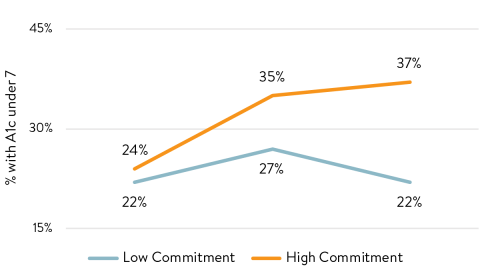
The Altarum Consumer Engagement (ACE) Measure
Why is patient engagement important?
A wide range of research shows that when patients are activated to engage with their own health, they take better care of themselves, improve their health, and drive down costs. Highly engaged patients are better at managing their own chronic conditions as well as avoiding unnecessary health care complications. Patient engagement is critical—but how do you measure it?
How does ACE measure patient engagement?
The ACE Measure is a scientifically-validated survey tool that measures three domains of patient engagement with just 12 questions. It takes less than two minutes to administer and provides an immediate set of patient engagement scores. The three ACE domains are:
- Commitment measures commitment to everyday health behaviors. Predicts overall health, adherence to medical guidance, and success at chronic disease management.
- Informed Choice measures desire to learn about health and choose providers and procedures. Predicts interest in Shared Decision Making (SDM) and thorough comparisons of health care options.
- Navigation measures skill and experience using health care benefits. Predicts ability to use benefits successfully and ask about costs before receiving care.
ACE in Action
...as a predictor of successful chronic disease self-management
Commitment is a strong predictor of how well patients with a chronic disease such as diabetes manage their condition. By monitoring ACE scores over time, providers can understand which patients are likely to do well, and which will need more help to be successful in managing their condition.
Figure 1: A1c Management Over Time by ACE Commitment

In a study by the US Air Force, diabetic patients’ blood sugar management (A1c) was monitored at three time points over an 8-month period. Diabetics with high Commitment showed a strong improvement over time, with the percentage of those with well-managed blood sugar growing by 50% (from 24% to 37% of patients). In contrast, those with low Commitment made no improvement at all, with only 22% well-managed at both the start and end points.
What is the ACE advantage over other patient engagement surveys?
- Scientific Origin—ACE was developed by testing hundreds of candidate questions on thousands of patients and using advanced statistical techniques to distill high predictive power and reliability into a compact survey tool. The three ACE domains are data driven based on unique psychological factors that have the strongest associations with real-world outcomes.
- Three Dimensions—Other conceptualizations of patient engagement only measure one aspect of patient engagement, which is often an over-simplification. Patients are complex. Many may be committed to their health (Commitment) but lack experience with health care (Navigation) or lack confidence in choosing between health care options (Informed Choice). ACE captures a much fuller patient profile.
- Easy to Use—ACE was designed to be highly accessible to the public, and easy to administer in a clinical setting. ACE is available for low and no-cost licensing, and can be administered in a clinical setting in less than 2 minutes.
ACE in Action
...as a recognized Quality Improvement Tool
ACE is recognized by the federal government as a Quality Improvement Tool (QIT). Health promotion interventions can be evaluated by measuring ACE before and after the intervention, and comparing the difference. Similarly, ACE can be used to measure the effectiveness of individual health coaches or providers in motivating patients to take charge of their health.
Figure 2: Diabetes Prevention Program Attendance Linked to Increase in Commitment Score

UCLA used ACE to study the effectiveness of a Diabetes Prevention Program (DPP) in promoting patient engagement. ACE was measured before and after the program. Respondents who attended at least nine DPP sessions improved their ACE Commitment scores more than three times (34%) as much as those who did not (10%). This shows participation in the DPP was strongly linked to improving engagement scores —and likely success at preventing diabetes. This evaluation suggests the DPP is effective at promoting engagement among those who attend.
Examples of Our Work
Applied Research and AnalyticsWorking with Altarum to implement ACE
Our health care researchers have worked with providers, employers, universities, and non-profits to design robust quality improvement initiatives, public outreach campaigns, develop continuing medical education (CMEs), and more. We will use our expertise to help you leverage patient engagement for your patients’ best health and outcomes. Applications of the ACE Measure include:
- Predicting successful chronic disease management, such as diabetes;
- Measuring quality improvement for health interventions; and
- Training providers to incorporate patient engagement into their care.
Need more evidence? View current research citing ACE as a patient engagement tool
Ready to get started?
Email ACE.Measure@altarum.org or download an overview to share.